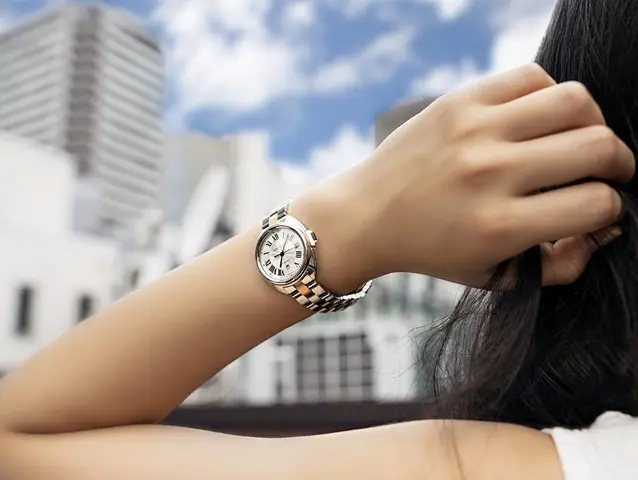As a fashion blogger passionate about style and elegance, one of the timeless dilemmas in accessorizing for women is deciding which wrist to wear a watch on. This seemingly simple decision can influence the overall balance and aesthetics of an outfit, reflecting personal taste and practicality. In this detailed guide, I will explore various considerations, traditions, and modern perspectives on whether a woman should wear her watch on her left wrist, right wrist, or even consider alternating. By the end of this article, you’ll have a comprehensive understanding of the factors influencing this choice and be empowered to make the best decision for your style.
Understanding Tradition and Practicality
Historical Perspective: Left or Right?
Traditionally, wearing a watch on the left wrist has been the norm for several reasons:
Convenience: Since the majority of people are right-handed, wearing a watch on the left wrist allows for easy access to adjust the time or use additional features like chronographs or pushers.
Comfort: The left wrist is typically less active in everyday tasks, reducing the risk of damaging the watch or causing discomfort.
Cultural Norms: In many cultures, including Western societies, watches have traditionally been worn on the left wrist as a standard practice.
However, times have changed, and today’s fashion landscape embraces individuality and personal preference more than ever before. The decision of which wrist to wear a watch on is now as much about style and comfort as it is about tradition.
Fashion and Style Considerations
Balancing Your Look: Symmetry and Aesthetics
When it comes to style, the placement of your watch can affect the overall balance of your outfit:
Dominant Hand: If you’re right-handed, wearing a watch on your left wrist can feel more natural and balanced, as it’s less likely to interfere with daily activities.
Statement Watches: A watch can be a statement accessory, and wearing it on the wrist that feels more comfortable or looks more aesthetically pleasing can enhance its impact.
Stacking Bracelets: Many women enjoy stacking bracelets on their non-watch wrist, creating a stylish contrast and allowing the watch to stand out as a focal point.
Watch Size and Fit
The size and weight of your watch can also influence which wrist feels more comfortable:
Heavier Watches: If your watch is heavy or oversized, you may prefer to wear it on the wrist that feels stronger or less encumbered during daily tasks.
Bracelet Watches: Watches with metal bracelets may feel more secure on one wrist versus the other, depending on how the clasp and links fit.
Personal Comfort and Lifestyle
Daily Activities and Comfort
Consider your daily routine and how wearing a watch on either wrist might impact your comfort and functionality:
Work Environment: If your job involves typing or manual tasks, wearing a watch on the non-dominant wrist might reduce interference and discomfort.
Sports and Activities: For active lifestyles, wearing a watch on the wrist that feels more secure during movement can prevent the watch from slipping or getting in the way.
Cultural and Symbolic Meaning
Cultural Norms and Symbolism
Different cultures and traditions may have specific guidelines or beliefs regarding which wrist is appropriate for wearing a watch:
Symbolism: In some cultures, the left wrist is associated with practicality and logic, while the right wrist is linked to creativity and intuition.
Occasions: Consider the cultural norms or expectations for formal events or occasions where wearing a watch on a specific wrist may be more appropriate.
Modern Trends and Alternatives
Alternating Wrist or Stackable Style
In recent years, fashion trends have embraced the idea of wearing watches on either wrist or even alternating between wrists based on mood or outfit:
Versatility: Switching between wrists allows for versatility in styling, allowing the watch to complement different outfits or accessories.
Stacking Watches: Some women enjoy wearing watches on both wrists or pairing a watch with bracelets on the opposite wrist for a layered look.
Practical Tips for Wearing a Watch
Fit and Adjustments
Ensure your watch fits comfortably and securely on your chosen wrist:
Watch Strap Length: Adjust the strap or bracelet to fit snugly without being too tight or loose, ensuring comfort and preventing slipping.
Daily Maintenance: Regularly check the fit of your watch to maintain comfort and prevent wear and tear on the strap or bracelet.
See Also: What Type Of Bra To Wear With A Backless Dress?
Personal Preference
Ultimately, the decision of which wrist to wear a watch on comes down to personal preference and comfort:
Experiment: Try wearing your watch on different wrists to see which feels more natural and comfortable for your daily activities.
Style Expression: Use your watch as a statement piece that reflects your unique style and personality, regardless of traditional norms.
Conclusion
In conclusion, the question of which arm a woman should wear a watch on is multifaceted, blending tradition, style, comfort, and personal preference. Whether you choose to follow historical norms, prioritize practicality, or express your individuality through fashion, the most important factor is feeling confident and comfortable in your choice.
As trends evolve and fashion becomes increasingly personalized, women have the freedom to experiment with different wrist placements, embrace asymmetry, and redefine traditional norms. By understanding the factors influencing your decision and considering your lifestyle and personal style, you can confidently wear your watch on the wrist that best complements your overall look and enhances your sense of self-expression. Ultimately, whether it’s your left wrist, right wrist, or even both wrists on different occasions, let your watch be a reflection of your unique style journey and a timeless addition to your wardrobe.
Related Topics:
What To Wear With Cargo Pants Female?
5 Reasons Why Do Skirts Look Bad On Me
What Can I Wear To Flatten My Stomach?

